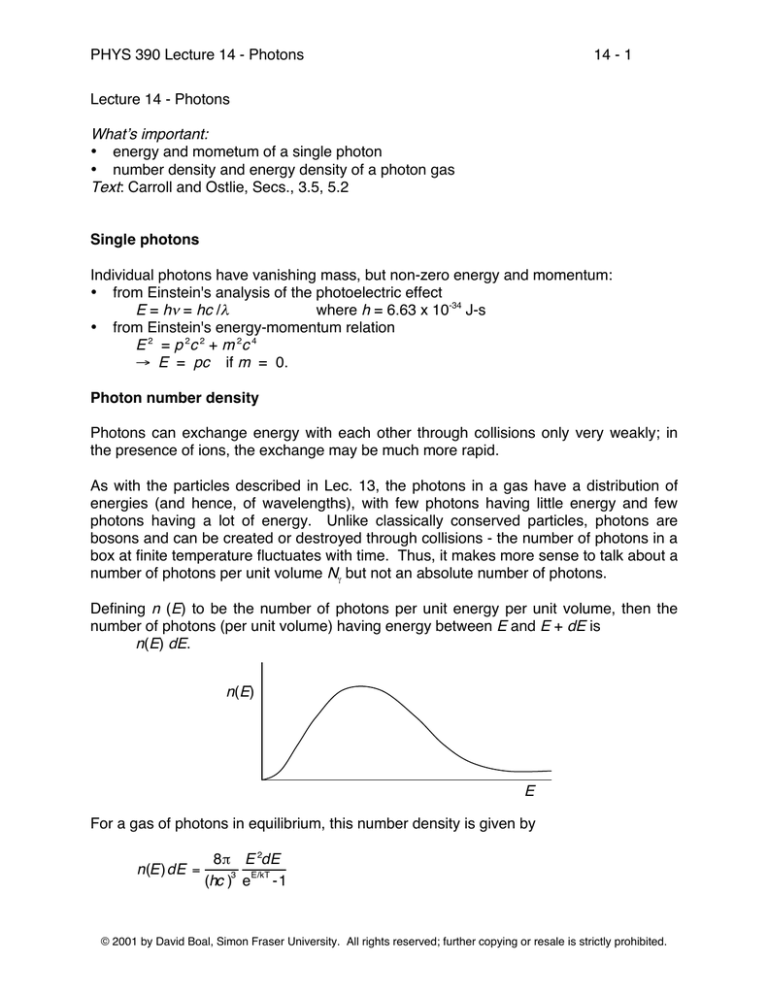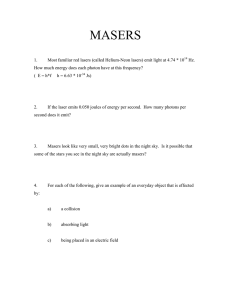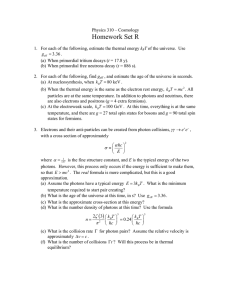PHYS 390 Lecture 14 - Simon Fraser University
advertisement

PHYS 390 Lecture 14 - Photons 14 - 1 Lecture 14 - Photons What’s important: • energy and mometum of a single photon • number density and energy density of a photon gas Text: Carroll and Ostlie, Secs., 3.5, 5.2 Single photons Individual photons have vanishing mass, but non-zero energy and momentum: • from Einstein's analysis of the photoelectric effect E = hν = hc /λ where h = 6.63 x 10-34 J-s • from Einstein's energy-momentum relation E 2 = p 2c 2 + m 2c 4 → E = pc if m = 0. Photon number density Photons can exchange energy with each other through collisions only very weakly; in the presence of ions, the exchange may be much more rapid. As with the particles described in Lec. 13, the photons in a gas have a distribution of energies (and hence, of wavelengths), with few photons having little energy and few photons having a lot of energy. Unlike classically conserved particles, photons are bosons and can be created or destroyed through collisions - the number of photons in a box at finite temperature fluctuates with time. Thus, it makes more sense to talk about a number of photons per unit volume Nγ but not an absolute number of photons. Defining n (E) to be the number of photons per unit energy per unit volume, then the number of photons (per unit volume) having energy between E and E + dE is n(E) dE. n(E) E For a gas of photons in equilibrium, this number density is given by n(E ) dE = 8! E 2dE (hc )3 eE/kT -1 © 2001 by David Boal, Simon Fraser University. All rights reserved; further copying or resale is strictly prohibited. PHYS 390 Lecture 14 - Photons 14 - 2 where n(E) includes 2 photon polarization states (kB = 1.38 x 10-23 J/K). The E2dE here and v2dv in the Maxwell-Boltzmann expression have the same root in d3p of the phase space element. To find the total density of photons Nγ, one must integrate this expression over energy 8# E 2dE N! = " n(E ) dE = " (hc )3 eE/kT -1 8!(k BT )3 = (hc )3 z 2dz " ez -1 or, using ∫ z 2 dz / (ez-1) = 2.404 3 "k T N! = 60.42 B $ # hc % Substituting numerical values for the constants gives Nγ = 2.02 x 107 T 3 (m-3), where the temperature T is quoted in K, and Nγ has units of m-3. This equation shows that the photon density increases like the third power of the temperature. Photon energy density The energy density of a photon gas follows from its number density. We define u(E) as the energy per unit volume of the photons with an energy between E and E + dE: 8! E 3dE u(E )dE = En (E ) dE = 3 E/kT (hc ) e -1 The total energy density Uγ of these photons can be found by integrating this expression 8# E 3dE U! = " u(E ) dE = " (hc )3 eE/kT -1 = 8!(k BT )4 (hc )3 z 3dz " ez -1 The integral has the value ∫ z 3 dz / (ez-1) = π4/15, giving us U! = 8" 5k B4 4 T 15h 3c 3 (neutrinos obey a similar, but not identical, expression). Substituting, one finds © 2001 by David Boal, Simon Fraser University. All rights reserved; further copying or resale is strictly prohibited. PHYS 390 Lecture 14 - Photons 14 - 3 Uγ = 7.565 x 10-16 T 4 (J/m3). where T must be quoted in K, and the resulting Uγ has units of J/m3. Dividing Uγ by Nγ the average energy per photon is then [average energy per photon] = 2.7 kBT. This result is similar, but not identical to what we saw in the previous lecture for ordinary particles, where the average kinetic energy per particle in three dimensions is 1.5 kBT Other representations of the energy density In some situations, it is more useful to express the energy spectrum u(E) as a function of frequency or wavelength. We'll use the wavelength distribution later in our discussion of stars, so let's show how the spectrum is calculated. We need to find the energy per unit volume for photons in the wavelength range of λ to λ + dλ, which we call u(λ)dλ. In our expression for u(E), we need to replace E → hc /λ and dE → (hc / λ 2)dλ (an irrelevant minus sign is discarded in taking the derivative) Thus 3 u( ! )d! = 8" # hc % hc d! (hc )3 $ ! & ! 2 eE/kT -1 u( ! )d! = 8" hc d! . ! 5 eE/kT -1 or The spectrum of photon wavelengths is similar to the spectrum of photon energies, small populations at very short or very long wavelengths, although the position of the most likely photon has shifted. Equating to zero the derivative of u(λ) with respect to λ gives the equation 0 = (!5) 1 1 1 1 d (# / " ) # / " + 5 (!1) # / " e 6 • # /" 2 • " e !1 " (e ! 1) d" where α = hc /kBT. © 2001 by David Boal, Simon Fraser University. All rights reserved; further copying or resale is strictly prohibited. PHYS 390 Lecture 14 - Photons 14 - 4 After just a few lines of algebra, we are left to solve α/λ = 5 (1 - e-α/λ). As a function of α/λ, the LHS has an initial slope of 1, while the RHS has a slope of 5. But at large α/λ, the RHS approaches 5. 5 α/λ The numerical solution to this equation gives α/λpeak = 4.9651, or the more frequently quoted λpeak = 0.2014052 hc /kBT. Substituting for the various constants in this equation, we have λpeak = 2.90 x 10-3 m / T(in K) Example The wavelength distribution of sunlight is peaked at around 500 nm. What is the surface temperature of the sun given λpeak = 500 nm? From λpeak = 2.90 x 10-3 m / T(in K), T = 2.90 x 10-3 / λpeak = 2.90 x 10-3 / 5 x 10-7 = 5800 K. © 2001 by David Boal, Simon Fraser University. All rights reserved; further copying or resale is strictly prohibited.







